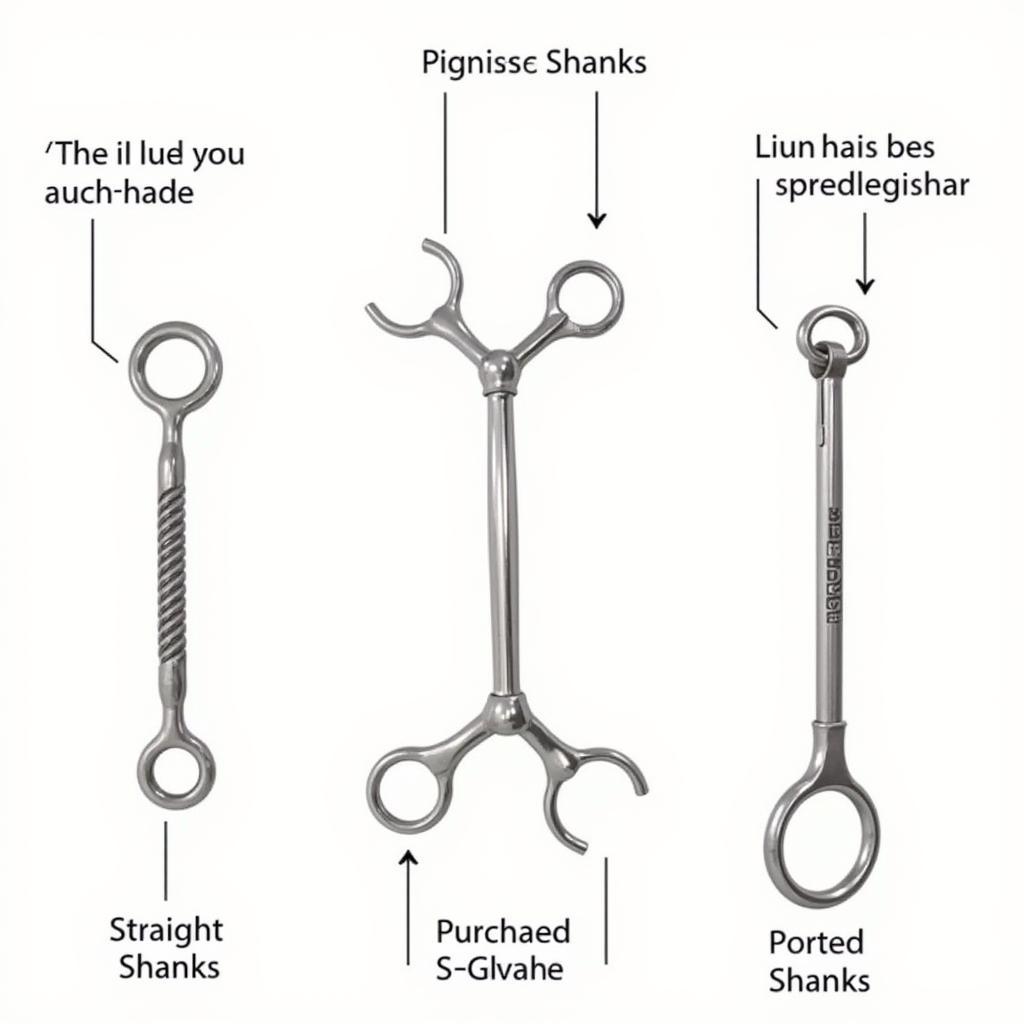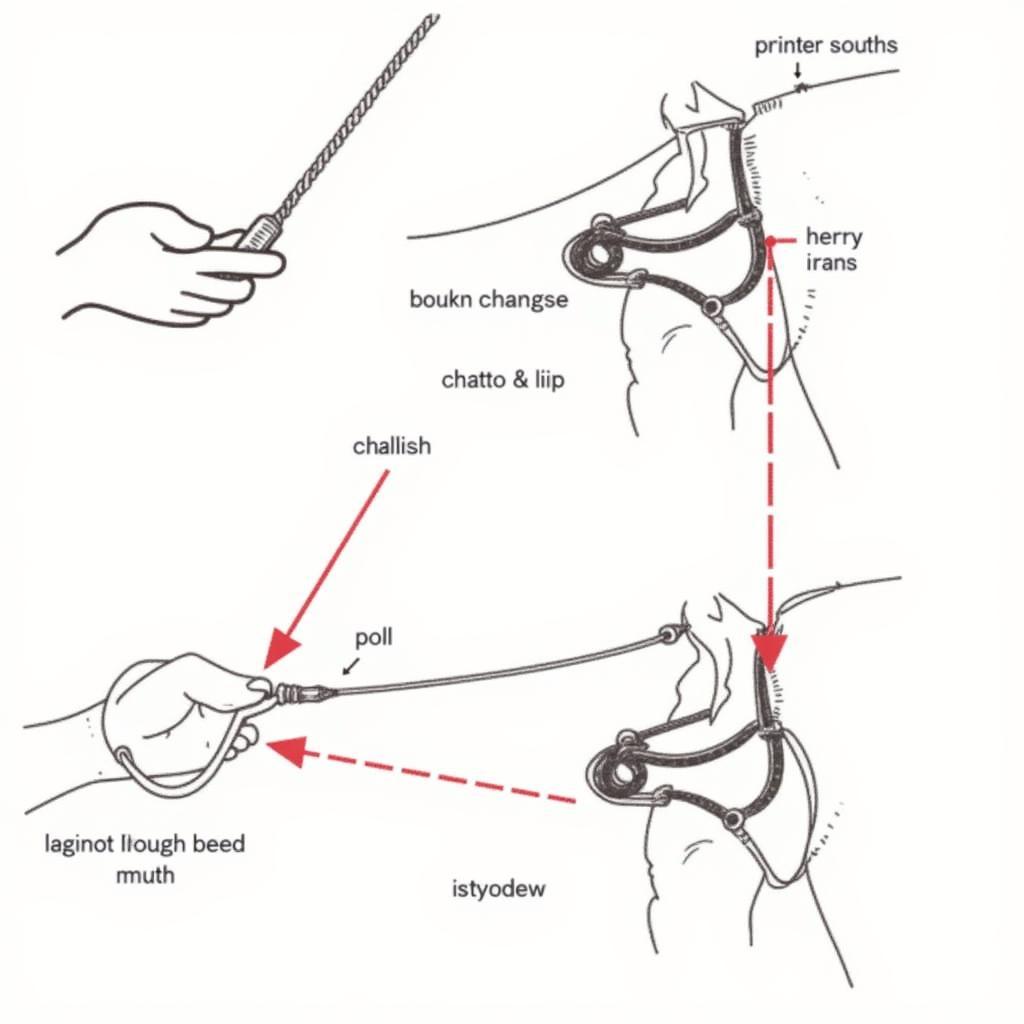A Horse Bit Shank is more than just a piece of metal; it’s a crucial communication tool between rider and horse. Understanding the different types of shanks, their mechanics, and how they influence pressure and communication is essential for any rider. Choosing the right shank is vital for effective training and ensuring the horse’s comfort and well-being.
Decoding the Mechanics of a Horse Bit Shank
The shank of a horse bit is the lever arm that extends from the mouthpiece. It’s this lever action that differentiates shanked bits from simpler snaffle bits. The length and style of the shank directly affect the leverage applied to the horse’s mouth, poll, and chin. Longer shanks generally result in more leverage, meaning a lighter rein aid translates to a stronger signal for the horse. Shanks can be straight, curved, or have a combination of shapes, each influencing the pressure points and the timing of the signal. Selecting the appropriate shank depends on the horse’s training level, discipline, and individual sensitivity.
The leverage action created by the shank multiplies the pressure from the rider’s reins. This magnification can be beneficial for refining cues and achieving more precise responses, but it also requires a skilled and sensitive hand. Improper use of a shanked bit can cause discomfort, confusion, and even pain for the horse. Therefore, riders must understand how to use these bits effectively and humanely.
A key element to consider is the purchase of the bit. The purchase refers to the slot where the reins attach. Different purchase positions alter the leverage and the angle of pull on the bit. A lower purchase increases leverage, while a higher purchase provides a milder action. Understanding the purchase options helps riders fine-tune the bit’s action to suit their horse’s needs. For instance, a horse working in a pelham bit for horses may require a different rein configuration compared to one in a curb bit.
 Types of Horse Bit Shanks
Types of Horse Bit Shanks
Types of Horse Bit Shanks and Their Effects
Several shank styles exist, each designed for specific purposes and riding disciplines. Straight shanks offer direct pressure, while curved or S-shanks can provide a more nuanced signal. Some shanks also feature ports or rollers, which can add complexity to the bit’s action.
- Straight Shanks: Provide direct pressure and are often used in disciplines like Western riding.
- S-Shanks: Offer a more gradual application of pressure and are common in various disciplines.
- Curved Shanks: Can enhance the lift and flexion of the horse’s head.
Choosing the best bit for a horse depends on various factors, including the horse’s temperament and the rider’s experience. For more information on choosing the right bit, you can refer to our article on the best bit for horse.
What are the different types of shanks on horse bits?
The types of shanks on horse bits include straight shanks, S-shanks, and curved shanks, each offering varying degrees of leverage and pressure points.
How does shank length affect bit action?
Shank length directly impacts leverage. Longer shanks amplify pressure, while shorter shanks create a milder effect.
 Horse Bit Shank Leverage and Pressure Points
Horse Bit Shank Leverage and Pressure Points
When to Use a Shanked Bit
Shanked bits are often used in disciplines requiring precise control and collection, such as Western riding, reining, and some English disciplines. They can be helpful for horses that are strong or require more refined cues. However, they are not suitable for beginners or horses that are sensitive or easily intimidated. Understanding the function of a chain shank horse can further illustrate the complexities of shanked bits.
“A well-chosen bit, including the appropriate shank, is like finding the right key for a lock,” says renowned equine trainer, Sarah Mitchell. “It unlocks the potential for clear communication and harmonious partnership between horse and rider.”
Are shanked bits suitable for all horses?
No, shanked bits are not suitable for all horses. They require a skilled rider and a horse that is responsive and not overly sensitive. Certain specialized bits, like the war bridle for horses, require even more expertise.
Choosing the Right Horse Bit Shank
Selecting the correct horse bit shank requires careful consideration of the horse’s individual needs and the rider’s skill level. It’s important to consult with a qualified trainer or equine professional to determine the most suitable bit for your horse. Factors to consider include the horse’s age, training level, discipline, and temperament. You can also explore various rings for horses used in conjunction with different bit types.
“Remember,” advises Dr. Emily Carter, DVM, specializing in equine dentistry, “the bit is a communication tool, not a punishment device. It should always be used with sensitivity and respect for the horse’s well-being.”
 Choosing the Right Horse Bit Shank for Your Horse
Choosing the Right Horse Bit Shank for Your Horse
Conclusion
The horse bit shank plays a vital role in communication between horse and rider. Understanding the different shank types, their mechanics, and how they influence pressure is crucial for effective and humane riding. Choosing the right shank for your horse requires careful consideration and consultation with experienced professionals. A properly fitted and appropriately used horse bit shank can enhance communication, improve performance, and contribute to a harmonious partnership between horse and rider.
FAQs
- What is the purpose of a shank on a horse bit?
- How do I choose the correct shank length for my horse?
- What are the different types of shanked bits?
- Are shanked bits suitable for beginner riders?
- How can I tell if my horse is comfortable with a shanked bit?
- What are the common mistakes riders make when using shanked bits?
- Where can I find more information on horse bitting?
When you need support, please contact Phone Number: 0772127271, Email: [email protected] Or visit us at: QGM2+WX2, Vị Trung, Vị Thuỷ, Hậu Giang, Việt Nam. We have a 24/7 customer service team.